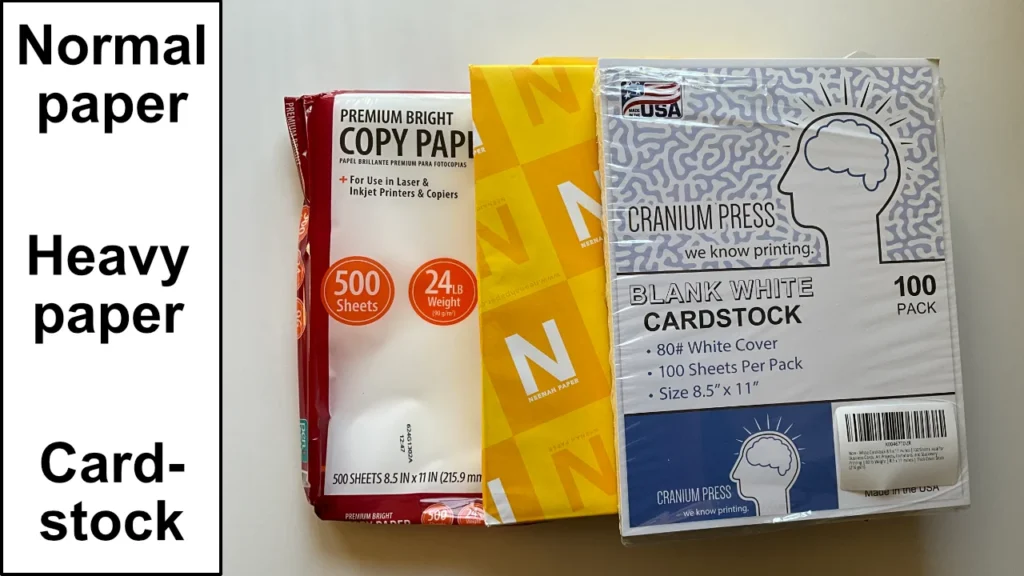We tested three kinds of paper with the Spεεδ Greek flash cards, printing 16 cards per page for that perfect handheld size (slightly smaller than half a 3×5 index card). The competition wasn’t even close: the heavy paper was better than the others on almost every metric.
Flash Card Comparison Table
| Product | Weight | Cost / page | Flash Card Pros | Flash Card Cons |
|---|---|---|---|---|
| Normal Paper – Hammermill Printer Paper | 24 lb (90 gsm) | $0.04 | Affordable and easy to print on—bright enough for clear Greek text (but with slight bleed-through on standard printers). | Too thin and light for flash cards; cards stick together and are hard to shuffle or separate, making practice sessions frustrating. Feels flimsy in hand. |
| Heavy Paper – Neenah Index Cardstock | 90 lb (163 gsm) | $0.04 | Strikes the perfect balance—sturdy enough to separate cards easily without sticking, holds up to repeated shuffling, and prints vibrantly for those phonetic details. Stacks neatly without bulk. | No significant problems. |
| Heavy Cardstock – Cranium Press Heavyweight White Cardstock | 80 lb according to the website, but it’s actually heavier than this (216 gsm) | $0.20 | Easiest to separate individual cards—thick and rigid, so they don’t clump, and high brightness ensures sharp, professional-looking prints for complex Greek scripts. | Sharp corners poke and irritate hands during use (almost like papercuts); stacks are bulky and take up more space; way overpriced for flash cards—5x the cost of heavy paper without enough benefits to justify it. |
There you go—that table captures the real testing insights, showing why heavy paper wins for making Spεεδ Greek flash cards that feel just right in your hands. Ready to master your vocab 10x faster? Grab the heavy paper and print away—it’s the practical choice for hands-free, effective learning on the go.
Ratings for use as flash cards
On a scale from 1-10, what rating does each type of paper get?
Normal Paper – 2/10
Normal paper is too thin and light: it is hard to separate one flash card from another when using normal paper. Even though the “normal paper” above is slightly heavier than normal, it is still too light and thin.
Heavy Cardstock – 5/10
The heavy cardstock makes it easy to separate one flash card from another, but it has three drawbacks that more than outweigh this advantage. (1) The corners feel very hard and sharp. Rather than giving way to your hand, they poke you over and over again, at times almost feeling like they are cutting your skin or giving you a papercut. Although flash cards made from this cardstock never actually cut my hands, they were painful to work with. (2) The other drawback is that a stack of flash cards made from the cardstock are pretty thick. The stack is significantly higher than with heavy paper, so they take up more space. (3) The cardstock is much more expensive. The per sheet cost is $0.19, more than 4x higher than with the $0.04 / sheet cost of the heavy paper.
Another problem with heavy cardstock is that retail printers sometimes can’t handle the paper. In our testing, there was a small but noticeable shift between front and back sides of the printed sheet. This means the front and back of the flash card doesn’t match exactly. It’s a slight inconvenience, but the flash cards are still usable. We expect this effect will be less prominent for higher quality printers.
Heavy Paper – 9/10
For these reasons, the heavy paper is our recommended choice for flash cards. Print it out with 16 cards per page (the layout used in all Spεεδ Greek flash cards). This leaves each flash card slightly smaller than half a standard 3×5 index card, a perfect size for testing yourself on Greek vocab. Here’s a quick comparison table to break it down—focusing on how each performs when making and using those flash cards, with key specs like brightness (for crisp prints), weight (for durability and feel), and cost (per sheet, based on current Amazon pricing).
As an Amazon Associate, SpeedGreek.com earns from qualifying purchases. Amazon links on this page are affiliate links. If you click on them and buy something, we receive a small commission. Our goal is to serve you by helping you find the best resources to learn Koine Greek.
